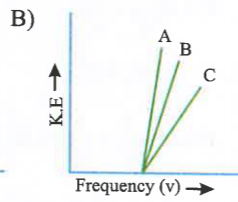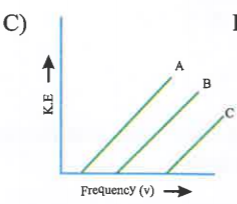Radiations of frequency 1015Hz is incident on three photosensitive surfaces. A,B and C. Following observations are recorded,
(a) Surface A. No photoemission occurs.
(b) Surface B. Photoemission occurs but the photoelectrons have zero kinetic energy.
(c) Surface C. Photoemission occurs and photoelectrons have some KE.
Based on Einstein's photoelectric equation, explain the three observations.
Step by step video & image solution for Radiations of frequency 10^(15)Hz is incident on three photosensitive surfaces. A,B and C. Following observations are recorded, (a) Surface A. No photoemission occurs. (b) Surface B. Photoemission occurs but the photoelectrons have zero kinetic energy. (c) Surface C. Photoemission occurs and photoelectrons have some KE. Based on Einstein's photoelectric equation, explain the three observations. by Physics experts to help you in doubts & scoring excellent marks in Class 12 exams.
Topper's Solved these Questions
- BOOK - CBSE MODEL PAPERCHAPTER - SAMPLE PAPER 2023 TERM IEXERCISE - SECTION D4videos
SAMPLE PAPER 2023 TERM I
- BOOK - CBSE MODEL PAPERCHAPTER - SAMPLE PAPER 2023 TERM IEXERCISE - SECTION B9videos
SAMPLE PAPER 2023 TERM I
- BOOK - CBSE MODEL PAPERCHAPTER - SAMPLE PAPER 2022 TERM IIEXERCISE - SECTION B16videos
SAMPLE PAPER 2022 TERM II
- BOOK - CBSE MODEL PAPERCHAPTER - SAMPLE QUESTION PAPER (THEORY)EXERCISE - Section – E6videos
SAMPLE QUESTION PAPER (THEORY)
Similar Questions
Radiation of frequency 1015 Hz is incident on two photosensitive surfaces P and Q. there is no photoemission from surface P. photoemission occurs from surface Q but photoelectrons have zero kinetic energy. Explain these observations and find the value of work function for surface Q.
View Solution(i) State two important features of Einstein's photoelectric equation.
(ii) Radiation of frequency 1015Hz is incident on two photosenstive surface P and Q. There is no photoemission from surface P. Photoemission occurs from Q but photoelectrons have zero kinetic energy. Explain these observation and find the value of work function for surface Q.View Solution
Knowledge Check
- Question 1 - Select One
Radiations of frequencies 8×1015 Hz and 5×1015 Hz are incident one after the another on the same photosensitive surface. If is found that the kinetic energies of the photo electrons emitted from the surface are in the ratio of 2:1 . What is the threshold frequency for the surface ?
A1.5×1015HzB2×1015 HzC2.5×1015 HzD3×1015Hz - Question 2 - Select One
Radiation of frequency v=9v0 is incident on a metal surface, having threshold frequency v0. The maximum velocity of the ejected photoelectrons is 6×106m/s. What will be the maximum velocity of the ejected photoelectrons , if v is reduced to 3v0 ?
A2×106 m/sB3×106 m/sC1.5×106 m/sD4×106 m/s - Question 3 - Select One
Photoelectron emission is observed for three different metals A,B and C. the kinetic energy of the fastest photoelectrons versus frequency 'v' is plotted for each metal. Which of the following graphs can be observed?
A B
B C
C D
D
If frequency of radiation incident on a photosensitive surface is doubled, the maximum kinetic energy of emitted photoelectrons also gets doubled.
View SolutionTwo photosensitive X and Y are exposed to radiations of frequency 1012Hz. Comment on threshold frequency of each surface if photoelectrons emitted from surface X have zero kinetic energy and that from surface Y have some positive kinetic energy .
View SolutionWhy photoelectrons ejected from a metal surface have different kinetic energies although the frequency of incident photons are same ?
View SolutionA photon of wavelength 5000λ strikes a metal surface with work function 2.20eV calculate
aTHe energy of the photon in eV
b. The kinetic energy of the emitted photo electron
c. The velocity of the photoelectronView SolutionThe work function of a surface is 3.1 eV. A photon of frequency1x1015Hz. Is incident on it. Calculate the incident wavelength is photoelectric emission occur or not.
View Solution

